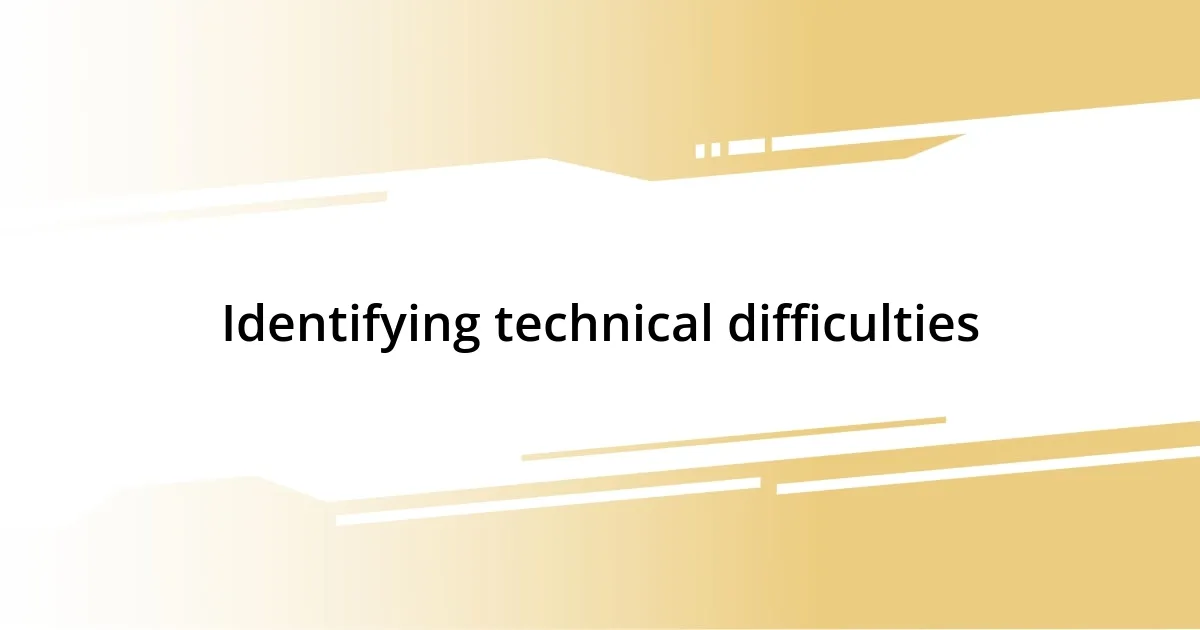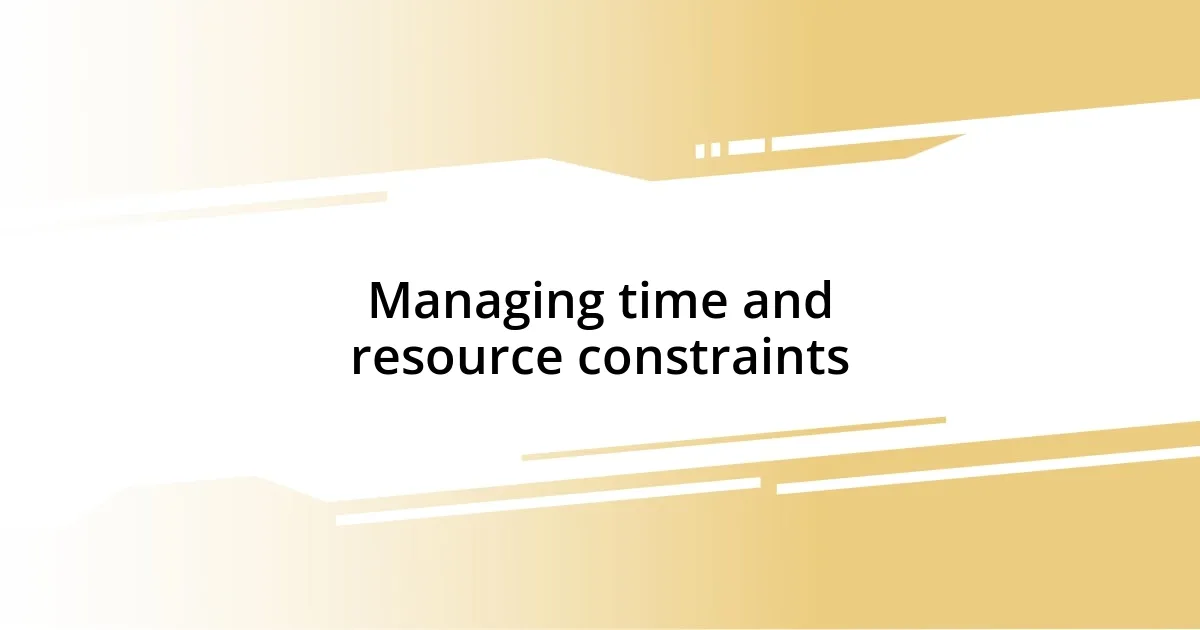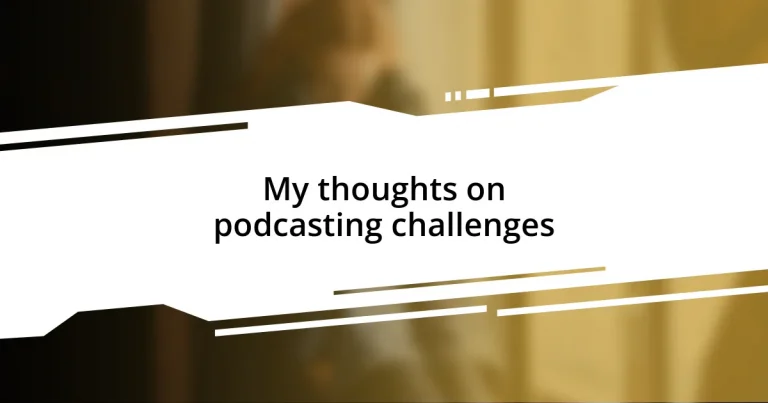Key takeaways:
- Identifying and targeting the right audience is crucial for successful podcasting, as misalignment can lead to disengagement.
- Technical difficulties, such as audio quality and equipment issues, can disrupt recording and must be recognized and addressed early.
- Balancing content quality with production efficiency is essential; consistent content delivery fosters audience loyalty.
- Engaging listeners through personal anecdotes and regular schedules enhances connection and retention, while strategic marketing and collaboration can expand reach.

Understanding common podcasting challenges
One of the most prevalent challenges I encountered in podcasting is honing in on the right target audience. I remember my early episodes where I struggled to grasp who I was truly speaking to. I’d post content that I thought would resonate well, only to realize afterwards that it didn’t connect with listeners the way I hoped. Have you ever felt that disconnect between what you love and what the audience craves?
Another significant hurdle is mastering audio quality. I distinctly recall recording an episode in my favorite coffee shop, only to discover that the background noise overshadowed the conversation. It was quite disheartening to put in so much effort, only to be let down by the sound. How do you find the balance between the vibe of a location and the clarity of your message?
Lastly, the consistency of content can be a daunting task, especially when life gets busy. I know there were weeks when I felt overwhelmed and tempted to skip an episode, but I realized that consistency builds trust with your audience. How do you stay committed, even when challenges arise? My journey taught me that planning ahead and establishing a routine can make all the difference.

Identifying technical difficulties
Identifying technical difficulties can be a real roadblock in the podcasting journey. I remember a time when I eagerly hit record, only to realize a few minutes into the episode that my microphone wasn’t even plugged in. The frustration of losing precious content was palpable; it’s a sinking feeling that many podcasters can relate to. Have you experienced a moment where all the excitement turns to panic over a technical glitch?
Here are some common technical difficulties that can derail a podcast episode:
- Audio issues: Poor sound quality, such as echoes or background noise.
- Equipment failure: Sudden shutdowns or malfunctions can halt progress unexpectedly.
- Software problems: Glitches during recording or editing can be incredibly frustrating.
- Connectivity issues: Dropped calls or unstable internet connections during interviews can disrupt flow.
- File format challenges: Different file types can make editing and sharing difficult.
Recognizing these hurdles early on can save you from future headaches. Embracing the learning curve while maintaining a sense of humor helps me navigate these tricky moments. It’s about finding solutions, not just dwelling on the problems.

Balancing content quality and production
Balancing content quality and production often feels like walking a tightrope. There were times when I prioritized my editing process, pouring hours into perfecting each episode, only to realize that my audience craved more timely content. It struck me that if I focused too heavily on quality, I risked compromising my podcast’s frequency. Have you ever faced the dilemma of speed versus polish in your creations?
I’ve learned to embrace a more pragmatic approach. For instance, I set specific production standards that ensure audio clarity and coherence without suffocating my creativity. One episode in particular, I barely edited the content and was amazed at the response; realness resonated with my listeners more than I expected. It’s a valuable lesson I’ve carried forward: producing consistently good quality doesn’t have to mean spending unending hours in post-production.
It’s vital to establish a rhythm that allows room for both high-quality content and efficient production. Scheduling chunks of time for recording, editing, and promotion has transformed my workflow. What I found surprising was the power of collaboration; involving a co-host or even a talented editor can help lighten the load without sacrificing quality. So, how do you ensure you bring your best while keeping an eye on the clock?
| Aspect | Content Quality | Production Efficiency |
|---|---|---|
| Description | Focus on delivering insightful and engaging material that resonates with your audience. | Streamline the workflow to reduce the time spent on each episode without losing core message integrity. |
| Key to Success | Crafting stories and insights that evoke emotions and foster connection with listeners. | Implementing structured schedules and possibly delegating editing tasks to others to ensure consistency. |
| Outcome | Stronger listener engagement and loyalty through valuable content. | Increased episode output and sustained audience interest, making podcasting a regular part of your audience’s routine. |

Engaging and retaining your audience
Engaging your audience goes beyond simply delivering good content; it’s about creating a connection that keeps them coming back for more. I remember setting up a listener feedback segment in one of my earlier episodes. The responses I received were eye-opening! It gave me a personal glimpse into what resonated with my listeners and highlighted the topics they were passionate about. Have you ever asked your audience for their thoughts? The insights can be invaluable in shaping your future episodes.
Retention often hinges on the stories we share and how relatable they are. I learned this when I opened up about my own struggles in a particular episode. To my surprise, the vulnerability made listeners reach out, sharing their own experiences. It was a powerful reminder that we’re all in this together. By weaving personal anecdotes into your podcast, you create an emotional connection—listeners feel like they know you. That’s when engagement transforms into loyalty.
Consistency is another cornerstone of keeping your audience engaged. I make it a point to release episodes on the same day every week. At first, I felt the pressure, but it quickly turned into a rhythm that my audience began to anticipate. Who doesn’t enjoy knowing when their next favorite episode will drop? Have you considered implementing a regular schedule? It can instill a sense of community and expectation that truly fosters long-term engagement.

Navigating marketing and promotion issues
Navigating marketing and promotion issues can be a daunting challenge for any podcaster. I remember when I first ventured into promoting my podcast; I naively assumed that great content alone would attract listeners. However, I quickly learned that simply uploading an episode isn’t enough. Discovering the right platforms to share my work and understanding social media algorithms felt like trying to crack a code. Have you felt the same frustration when trying to get your podcast in front of the right audience?
Using targeted strategies to promote my episodes became essential. I started to create eye-catching visuals and engaging snippets to share across social media. I even experimented with different times to post and found that weekends brought more interaction than weekdays. It made me wonder—how well do you know your audience’s online habits? Engaging with them where they mostly hang out online has become a game-changer for me, fostering a sense of community alongside an increase in listeners.
Another crucial element is collaboration with other creators. I reached out to fellow podcasters for cross-promotions, which opened up a whole new audience for both of us. It felt like a win-win—each episode introduced me to listeners who were already eager for content like mine. Have you ever thought about partnering with other creators? The relationships can lead to unexpected opportunities and help you overcome the visibility hurdle together.

Managing time and resource constraints
Managing time and resource constraints can often feel like balancing on a tightrope. I recall a time when I was juggling multiple episodes, interviews, and personal commitments all at once. I learned the hard way that without a strategic approach, deadlines can easily slip away. Have you ever felt that pressure? I found that creating a detailed editorial calendar not only organized my thoughts but also made each task more achievable.
Finding the right tools can be a real game changer. I started experimenting with project management apps that help keep everything in one place. The satisfaction of checking off a completed task is unparalleled! It also allows me to allocate my time more effectively. What tools have you tried? You may be surprised by how technology can simplify your processes, giving you more time to focus on creating meaningful content.
Prioritization is crucial in podcasting. There was a period when I was tempted to dive into multiple topics, but soon realized that not every idea deserved my attention at that moment. Focusing on what truly excites me not only made the podcast stronger but also kept my enthusiasm alive. Have you found yourself distracted by too many ideas? Narrowing down your focus might just elevate your production value and provide clarity amid the chaos.

Overcoming fears and building confidence
Overcoming fears in podcasting is a journey I know all too well. When I first hit that record button, my heart raced with anxiety. What if my voice sounded awful? What if I stumbled over my words? It took practice to realize that it was natural to feel nervous. Have you ever faced those butterflies before speaking? I found that the more I recorded, the more confident I became, transforming sheer panic into passion.
Building confidence also means embracing vulnerability. I remember sharing an episode where I talked about my biggest mistakes in podcasting. Instead of criticism, I received support and understanding from listeners who appreciated my honesty. It made me reflect—don’t we all crave authenticity? This experience not only fortified my confidence but also solidified a deeper connection with my audience.
Another effective strategy for overcoming self-doubt is visualization. Before hitting record, I take a moment to envision my ideal listener and how my words can impact them. Practicing this technique has turned my jitters into excitement. Have you ever tried visualizing your audience? It can transform your mindset from fear to purpose, fostering an incredible boost in confidence as you share your voice with the world.














